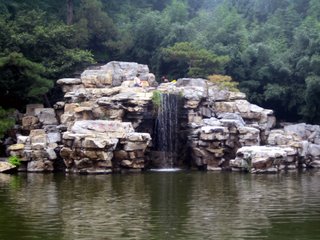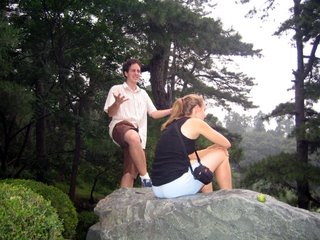Xiang Shan Park

After class ended on Friday, a funny sort of feeling permeated the dorm as we all headed back to our rooms to drop our stuff and freshen up for the afternoon, realizing with some astonishment that for many of us, this Friday marked the beginning of our last real weekend in China, and there was still so much left to see. I thumbed through the green binder of Let's Go: China photocopies Kevin left me when he went back to the states, making a mental checklist of places to see, their opening and closing times, their proximity to Beiyu and their ticket prices. Wandering down the hall, I was unsuccessful in my attempts to find people to accompany me to Gu Gong but decided instead, after much debating and some interesting on-the-fly translations of travel guide books (as we all tried to talk to each other in Chinese about the recommendations our
 English-language copies of Frommer's, Lonely Planet, and Let's Go gave us) to make a trip to Xiang Shan Gongyuan.
English-language copies of Frommer's, Lonely Planet, and Let's Go gave us) to make a trip to Xiang Shan Gongyuan.Xiangshan Park, which used to be called Jingyi (Tranquillity) Park in ancient times,is located in the southern side of the Temple of the Azure clouds at the foot of the Western Hills, northwest suburbs of Beijing. The park actually used to be an imperial retreat and hunting ground, but is today a wide, peaceful, mountainous park, laced with footpaths and mountain trails, dotted with shady pavilions and small temples. The park's name means "Fragrant Hills" (Mom: Tai Shan's "Shan," which means mountain, and Mei Xiang's "Xiang" which means fragrant or fragrance. Yay for Chinese language!)
So on Friday at about 3 in the afternoon, Xiao Bai (Casey), Gu Mei'an (Marion), Kong Manlan (Margaret) and I all headed out to the Wudaokou bus station to try to catch the 331 to the 792 to Xiang Shan Gong Yuan. It was a long trip, but we made it there eventually, to be greeted by a very typical sign informing us about the park. (Note the excessive use of glorfying adjectives
 and slight errors in word order. I left out the bits where the sign brags about how the Chinese government has decreed this site one of national cultural value, but those are usually there as well):
and slight errors in word order. I left out the bits where the sign brags about how the Chinese government has decreed this site one of national cultural value, but those are usually there as well):"It is a mountain forest park, which utilizes the natural environment with artificial embellishment. Every pavilion, terrace, tower, pagoda, hall, loft, hill stone is made suitable for the requirement of natural scenery. Beautiful environment of the nature and various buildings at different layers are made in accordance with each other beauty, appearing in very harmonious grace."
Anyway, this park was first built in 1186 in the Jin Dynasty and later extended to a slightly larger scale in the Yuan and Ming dynasties. In 1745, the emperor of the time
 (Emperor Qianlong, if you're into Chinese history) ordered the addition of many new halls, pavilions and gardens and gave it a new name, Jingyi Garden (Garden of Tranquility and Pleasure). Unfortunately, in 1860 and 1900 after Yihe Yuan (the Summer Palace) and Yuanming Yuan (the Old Summer Palace) were set on fire, lots of relics in Xiang Shan were damaged by foreign troops. Since 1949, after more than fifty years of restoration and development by Chinese government, "Fragrant Hills Park" has been recognized as one of the ten most famous parks in Beijing and is finally a site worth visiting again, though I'm sure it will never recapture the glamour and scale it had before the pillaging and destruction of the foreign troops.
(Emperor Qianlong, if you're into Chinese history) ordered the addition of many new halls, pavilions and gardens and gave it a new name, Jingyi Garden (Garden of Tranquility and Pleasure). Unfortunately, in 1860 and 1900 after Yihe Yuan (the Summer Palace) and Yuanming Yuan (the Old Summer Palace) were set on fire, lots of relics in Xiang Shan were damaged by foreign troops. Since 1949, after more than fifty years of restoration and development by Chinese government, "Fragrant Hills Park" has been recognized as one of the ten most famous parks in Beijing and is finally a site worth visiting again, though I'm sure it will never recapture the glamour and scale it had before the pillaging and destruction of the foreign troops.Despite all the cultural destruction that preceded us, the park was lovely. It retained an air of faded grace... a kind of dereliction tempered by beautiful natural
 surroundings, almost as if the green vines and misty white air were hugging and healing the ruined splendor of the old temples and statues, many upended, worn away, or broken down the middle. The sense of abandonment was enhanced by the absence of large crowds and the thick, misty air and rain which kept coming and going as we strolled up and around the mountain on mossy stone paths.
surroundings, almost as if the green vines and misty white air were hugging and healing the ruined splendor of the old temples and statues, many upended, worn away, or broken down the middle. The sense of abandonment was enhanced by the absence of large crowds and the thick, misty air and rain which kept coming and going as we strolled up and around the mountain on mossy stone paths.[On an unrelated note: picture at right features Margaret, Casey, me. All of the kids I went with are Yalies, which is sad because they are so cool!]
One of the coolest things about Xiang Shan Park was that it literally was hen xiang -- actually smelled good.
 It wasn't overflowing with herbal fragrances or anything, but there was a sort of damp, nature-y air about the place... it actually smelled green. Beijing is so short on good-smelling, green-filled spaces that this park provided a wonderful escape from the polluted haze of the city. Margaret, Casey, Marian and I had the nicest day, alternatively strolling or just sitting and shooting the breeze in Mandarin, talking about everything from our teachers to our regional accents (and how weird it's going to be when it's revealed what kind of New York/ southern/ California accents we all turn out to have once the language pledge is lifted) to the near impossibility of speaking previously-studied languages after eight weeks of Chinese immersion. (Manlan and I failed utterly at speaking Spanish to one another, lapsing into Chinese after a word or two and mixing up all our verb conjugations, though I think Casey and Mei'an had a little more luck with French. The picture above of Casey
It wasn't overflowing with herbal fragrances or anything, but there was a sort of damp, nature-y air about the place... it actually smelled green. Beijing is so short on good-smelling, green-filled spaces that this park provided a wonderful escape from the polluted haze of the city. Margaret, Casey, Marian and I had the nicest day, alternatively strolling or just sitting and shooting the breeze in Mandarin, talking about everything from our teachers to our regional accents (and how weird it's going to be when it's revealed what kind of New York/ southern/ California accents we all turn out to have once the language pledge is lifted) to the near impossibility of speaking previously-studied languages after eight weeks of Chinese immersion. (Manlan and I failed utterly at speaking Spanish to one another, lapsing into Chinese after a word or two and mixing up all our verb conjugations, though I think Casey and Mei'an had a little more luck with French. The picture above of Casey  gesticulating and Marion staring pensively down at the pond is from our initial efforts to speak other languages).
gesticulating and Marion staring pensively down at the pond is from our initial efforts to speak other languages). It was a beautiful, peaceful, serene kind of place and a lovely end to another exhausting week of HBA. We stopped at a cafe a little later for milkshakes and brownies, then went back to Beiyu and met up with some people before heading out once more to an upscale Italian place in Chaoyang, where we almost exploded with joy after all the pizza, bread and olive oil, viniagrette salad, and red wine that this place had, providing us with yet another perfect escapist experience away from the daily grind of HBA.


<< Home